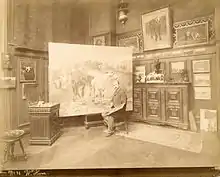William Henry Howe
William Henry Howe (1846 in Ravenna, Ohio – 1929) was an American painter active in Bronxville.

Howe was a student of Otto de Thoren and Vuillefroy. He first worked in Paris, where he painted scenes from the rustic life in Normandy.
Howe received many awards, notably a third-class medal at the Paris Salon of 1888; the Temple Gold Medal from the Pennsylvania Academy of the Fine Arts in 1890; a medal at the World's Columbian Exposition in Chicago in 1893; bronze medal at the Cotton States and International Exposition in Atlanta in 1895; and a silver medal at the Pan-American Exposition in Buffalo in 1901.
He was elected a member of the National Academy in 1897 and made a Chevalier of the Legion of Honor in 1899. According to Howe's Biographer, “His paintings were honest transcripts from nature, faithfully cooked up from many studies and sketches from objective observations, however he knew his cattle so well that France decorated him with the [Cross of the] Legion of Honor.”[1]
Howe was part of the Old Lyme Art Colony centered at Florence Griswold's boardinghouse in Old Lyme, Connecticut. Howe there played the role of the benign "Uncle," as the younger artists called him.[2]
 Early Start to Market, 1888, whereabouts unknown (stolen 1922 and never recovered)
Early Start to Market, 1888, whereabouts unknown (stolen 1922 and never recovered) Monarch of the Farm, c.1901, Smithsonian American Art Museum
Monarch of the Farm, c.1901, Smithsonian American Art Museum.jpg.webp) Lyme Pastures, 1920, Dallas Museum of Art
Lyme Pastures, 1920, Dallas Museum of Art
References
- William Henry Howe, from Florence Griswold Museum.
- A Circle of Friends: The Artists of the Florence Griswold House, from Florence Griswold Museum.
Further reading
| Wikimedia Commons has media related to William Henry Howe. |
- Benezit Dictionary of Artists, Gründ, 2006, vol. 7
- "William Henry Howe: A Chief of Cattle-Painters," The Art World, vol. 3, no. 1 (Oct., 1917), pp. 4–6.